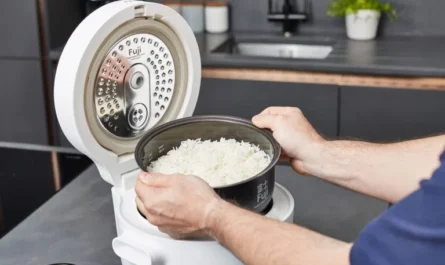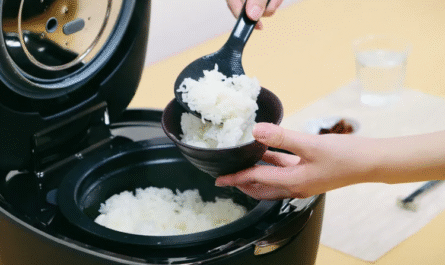For many sushi lovers, a rice cooker is an essential kitchen appliance. However, sometimes accidents happen, and you might find yourself with a burnt rice cooker pot. Knowing how to clean burnt rice cooker pot is crucial to maintaining its longevity and ensuring your rice always tastes perfect.
It’s not uncommon to face the challenge of a burnt rice cooker pot, but don’t worry! With the right techniques and a bit of patience, you can restore your pot to its original condition. This guide will provide you with step-by-step instructions on how to tackle this common issue.

Understanding the Problem
Before diving into the cleaning process, it’s essential to understand why your rice cooker pot might get burnt. Overcooking, using the wrong rice-to-water ratio, or a malfunctioning rice cooker can lead to burnt residue at the bottom of the pot. Identifying the cause can help you prevent future occurrences.
Common Causes of Burnt Rice
- Incorrect water levels.
- Old or malfunctioning rice cooker.
- Cooking rice varieties that require different water ratios.
Preparing for Cleaning
Before starting, ensure your rice cooker is unplugged and has cooled down completely. This will prevent any injuries and make the cleaning process easier. Gather the necessary supplies: a soft sponge, baking soda, vinegar, dish soap, and warm water.
Essential Cleaning Supplies
- Baking soda a natural abrasive that helps lift burnt residue.
- Vinegar known for its ability to cut through grease and grime.
- Soft sponge to avoid scratching the pot’s surface.
- Warm water assists in loosening the burnt particles.
Step-by-Step Cleaning Process
Step 1: Soak the Pot
Fill the pot with warm water and add a few tablespoons of dish soap. Let it soak for at least 30 minutes. This will help loosen the burnt rice and make it easier to scrub off.
Step 2: Use Baking Soda & Vinegar
After soaking, sprinkle a generous amount of baking soda over the burnt areas. Add a cup of vinegar and let the mixture fizz for a few minutes. This chemical reaction helps break down the burnt residue.
Step 3: Scrub Gently
Using a soft sponge, gently scrub the pot to remove the burnt particles. Avoid using steel wool or harsh scrubbing pads as they can damage the non-stick surface.
Step 4: Rinse & Repeat if Necessary
Rinse the pot thoroughly with warm water to ensure all baking soda and vinegar residues are removed. If any burnt spots remain, repeat the process.
Preventing Future Burnt Pots
Tip 1: Use the Right Water Ratio
Ensure you’re using the correct rice-to-water ratio. Different types of rice require different amounts of water, so it’s crucial to follow the instructions specific to the rice you’re cooking.
Tip 2: Regular Maintenance
Regularly check your rice cooker for any signs of wear and tear. If your rice cooker is old or malfunctioning, it might be time to invest in a new one. For more guidance on choosing a durable rice cooker, you can visit most durable rice cooker.
Tip 3: Experiment with Cooking Times
Different rice varieties might require different cooking times. Experiment to find the perfect settings for your rice cooker.
Why It’s Important to Keep Your Rice Cooker Clean
A clean rice cooker ensures that your rice is always fresh and free from residual odors. Regular cleaning also prolongs the life of your appliance and ensures optimal performance.
Additional Tips for Stubborn Stains
Using Lemon Juice
If the burnt residue is particularly stubborn, try using lemon juice. The acidity of the lemon helps break down burnt particles. Simply apply lemon juice to the affected areas, let it sit for a few minutes, and then scrub gently.
Commercial Cleaners
For those who prefer commercial cleaning solutions, look for non-toxic products specifically designed for kitchen appliances. Ensure they are safe to use on non-stick surfaces.
Alternatives to Rice Cooker Usage
While rice cookers are convenient, there are alternative methods to cook rice that might prevent burning. Stovetop cooking gives you more control over the heat and water levels.
Conclusion
Knowing how to clean burnt rice cooker pot is essential for sushi lovers and anyone who values a well-maintained kitchen. By following these steps, you can ensure your rice cooker remains in top condition, delivering perfect rice every time.
For more tips on maintaining your rice cooker, visit rice cooker smells bad guide. Additionally, for a deeper understanding of different rice cooker types, check out this external resource.

FAQ
How often should I clean my rice cooker?
It’s best to clean your rice cooker after every use to prevent any buildup and ensure it remains in good condition.
Can I use a dishwasher to clean the rice cooker pot?
While some rice cooker pots are dishwasher safe, it’s generally recommended to hand wash them to prevent any damage to the non-stick coating.
What should I do if my rice cooker pot is damaged?
If the pot is damaged beyond repair, consider purchasing a replacement pot or investing in a new rice cooker. For guidance, see our rice cooker size guide.
This article contains affiliate links. We may earn a commission at no extra cost to you.




